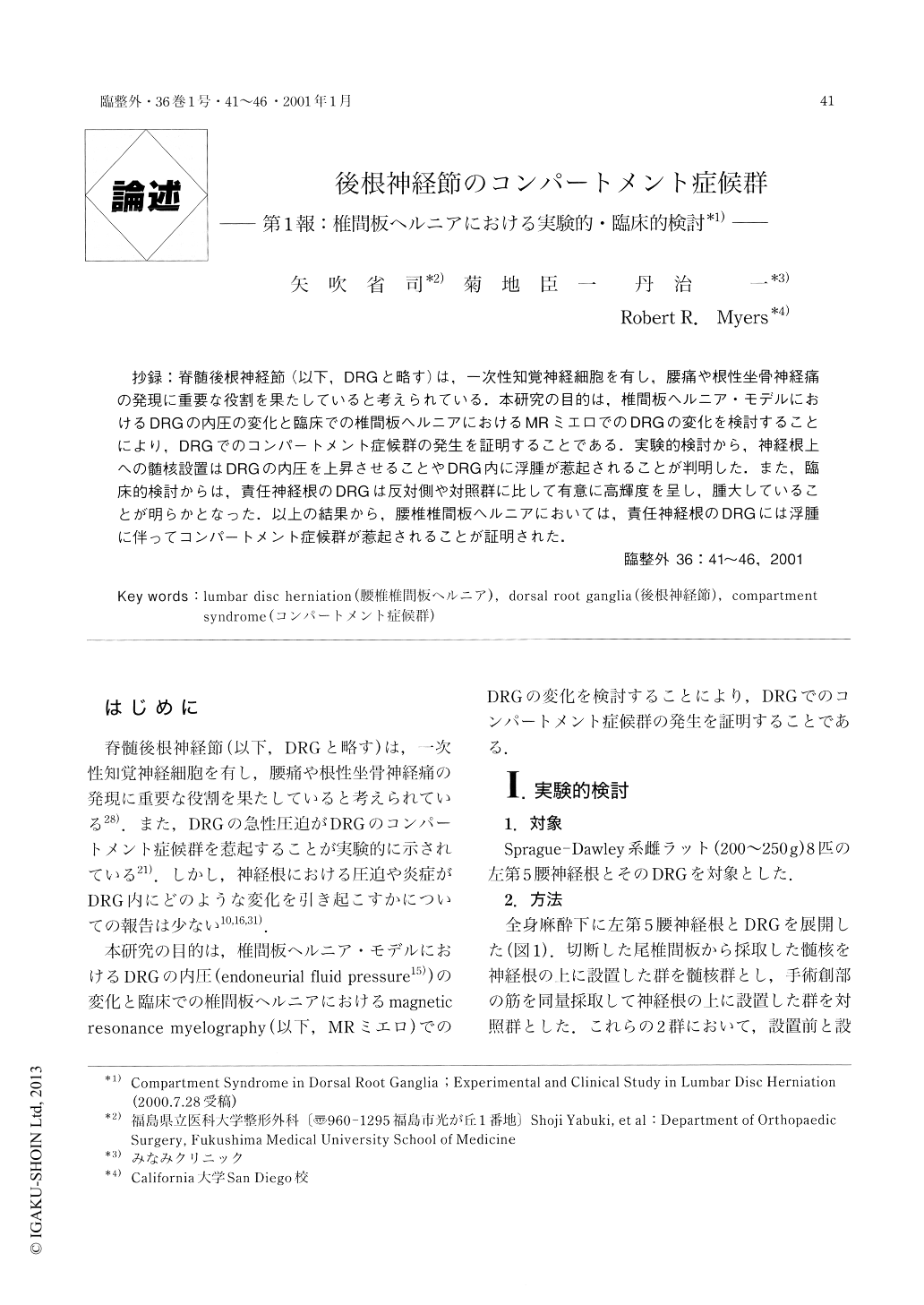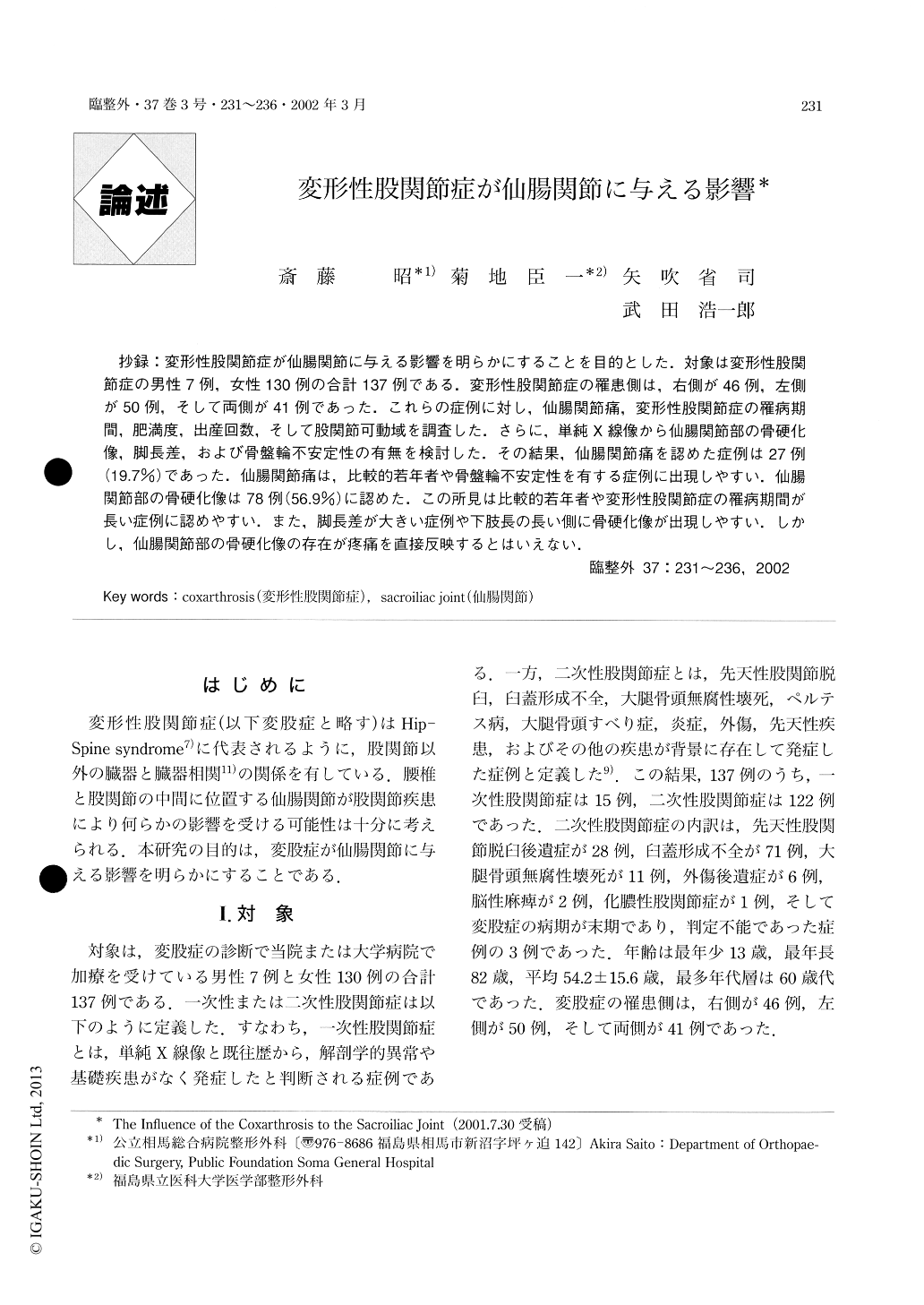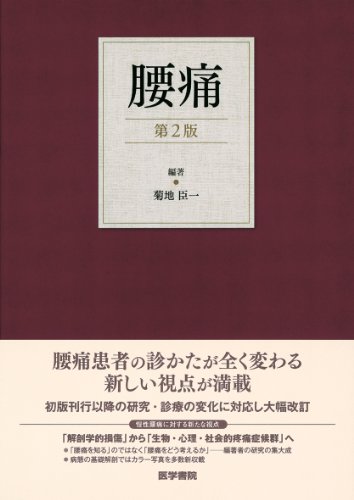5 0 0 0 OA 腰椎背筋群におけるコンパートメント症候群の病態と治療
- 著者
- 菊地 臣一
- 出版者
- 社団法人 日本リハビリテーション医学会
- 雑誌
- リハビリテーション医学 (ISSN:0034351X)
- 巻号頁・発行日
- vol.32, no.8, pp.531-541, 1995-08-18 (Released:2009-10-28)
- 参考文献数
- 25
- 被引用文献数
- 1
1 0 0 0 OA 医療人は国民にどんな貢献が出来るか
- 著者
- 菊地 臣一
- 出版者
- 公益社団法人 全日本鍼灸学会
- 雑誌
- 全日本鍼灸学会雑誌 (ISSN:02859955)
- 巻号頁・発行日
- vol.65, no.3, pp.134-143, 2015 (Released:2017-01-19)
- 著者
- 矢吹 省司 菊地 臣一 丹治 一 Robert R. Myers
- 出版者
- 医学書院
- 巻号頁・発行日
- pp.41-46, 2001-01-25
抄録:脊髄後根神経節(以下,DRGと略す)は,一次性知覚神経細胞を有し,腰痛や根性坐骨神経痛の発現に重要な役割を果たしていると考えられている.本研究の目的は,椎間板ヘルニア・モデルにおけるDRGの内圧の変化と臨床での椎間板ヘルニアにおけるMRミエロでのDRGの変化を検討することにより,DRGでのコンパートメント症候群の発生を証明することである.実験的検討から,神経根上への髄核設置はDRGの内圧を上昇させることやDRG内に浮腫が惹起されることが判明した.また,臨床的検討からは,責任神経根のDRGは反対側や対照群に比して有意に高輝度を呈し,腫大していることが明らかとなった.以上の結果から、腰椎椎間板ヘルニアにおいては,責任神経根のDRGには浮腫に伴ってコンパートメント症候群が惹起されることが証明された.
1 0 0 0 神経根内血管のセロトニン感受性-馬尾慢性圧迫下での検討-
セロトニンとセロトニン拮抗薬投与前後での神経根内血管と血流量の変化を検討した。方法:雑種成犬35頭。A群;非手術群、B群;バルーンのみを挿入したsham群、C群;馬尾に圧迫をかけ、解析時にバルーンを除去した群、D群、E群、F群、G群;馬尾に圧迫をかけ、解析時にバルーンを膨らませたままの群の7群を設定した。解析時にA, B, C, D群にはセロトニン0.5μM、E群、F群はセロトニン投与前にセロトニン受容体拮抗薬(0.5μg/ml、0.05μg/ml)、G群にはセロトニン投与後にセロトニン受容体拮抗薬(0.5μ9/ml)を投与した。デジタルハイスコープを用いて仙椎神経根の血管を記録し、血管径と血流量の計測を行なった。圧迫部位の神経根を採取し組織学的検討を行った。結果:[血管径]AとB群はセロトニン投与後、血管が拡張した。CとD群では、血管が収縮した。EとF群では、血管収縮が抑制された。G群では、血管が収縮は抑制されなかった。[血流量]AとB群でセロトニン投与後に血流量は減少しなかった。CとD群では血流量は減少した。E、F群およびG群では、血流量が増加した。電子顕微鏡学的検討では、馬尾圧迫下の神経根内血管のtight junctionが破壊されていた。考察:セロトニンは圧迫のない神経根内血管は拡張させ、慢性圧迫下の神経根内血管では血管収縮と血流量の減少を引き起こす。5-HT_<2A>受容体拮抗薬は、セロトニンによる慢性圧迫下での神経根内血管収縮反応と血流量の減少を抑制した。5-HT_<2A>受容体拮抗薬は、馬尾・神経根の血流低下により引き起こされる間欠跛行を改善させる可能性がある。今後、腰部脊柱管狭窄の保存療法の1手段として、有効性が期待できる。
1 0 0 0 OA 心因性疼痛を考える:用語としての認知性疼痛の提案
- 著者
- 牛田 享宏 野口 光一 細川 豊史 田口 敏彦 高橋 和久 住谷 昌彦 菊地 臣一
- 出版者
- 日本疼痛学会
- 雑誌
- PAIN RESEARCH (ISSN:09158588)
- 巻号頁・発行日
- vol.33, no.3, pp.183-192, 2018-09-15 (Released:2018-11-06)
- 参考文献数
- 11
Chronic pain is one of the common health problems among the general population. Various mechanisms are involved in the pathophysiology of pain, and a correct understanding of its pathophysiology or cause is important for an optimal management of pain. In terms of the physiological anatomy, pain with physical ⁄ organic causes can be classified mainly as “nociceptive pain” or “neuropathic pain.” However, there is also pain that does not fall into either of these two categories. This type of pain is often considered as a third classification, but its definition has not been standardized globally. In Japan, this type of pain is often called “psychogenic pain,” even when the pain is not attributed to psychological factors. However, it may not be an appropriate term for this particular type of pain. Firstly, because there is no standardized definition, physicians differ in how they classify pain as “psychogenic.” Additionally, the term “psychogenic” could give negative impressions to patients, which can deteriorate the patient–physician relationship and may result in poor treatment outcomes. In this paper, we have discussed these problems and proposed a new term “cognitively perceived pain” for this third category of pain, with the aim to foster a more appropriate, and easy–to–understand classification of pain. “Cognitively perceived pain” encompasses all pain that is neither nociceptive nor neuropathic pain, including that described as centralized pain or sensory hypersensitivity, in addition to psychogenic pain according to its original meaning (i.e. pain attributable to psychological factors). Because pain is perceived in the brain, the presence of any pain implies the impairment or abnormality of cognition. The proposed term is straightforward to convey the essence of pain without including any negative–sounding words. We hope that this term and its concept will be widely accepted, and help to increase understanding of this poorly defined category of pain.
1 0 0 0 OA 腰椎椎間板ヘルニアに対する神経根ブロックの治療効果
- 著者
- 紺野 慎一 菊地 臣一
- 出版者
- 日本腰痛学会
- 雑誌
- 日本腰痛学会雑誌 (ISSN:13459074)
- 巻号頁・発行日
- vol.9, no.1, pp.89-94, 2003 (Released:2008-06-30)
- 参考文献数
- 9
神経根ブロック,硬膜外ブロックおよびブロックを行わずに治療を行った例の3群間の治療成績の差異を明らかにすることを第一の目的とした.第二には,神経根ブロックにおけるステロイド使用の意義を明らかにすることを目的に,椎間板ヘルニアに対する神経根ブロックの治療効果をステロイド使用群と非使用群とで比較した.腰椎椎間板ヘルニアに対するブロック療法群と非ブロック療法群の成績は,治療後6カ月の時点ではブロック療法群の方が有意に成績が良かった.しかし,治療後2年では,両者の差はなかった.ブロック群では,症状軽快または消失までの期間が非ブロック群に比べ有意に短かった.また神経根ブロック群の方が硬膜外ブロック群よりも有症状期間をさらに短縮していた.神経根ブロックにおけるステロイド使用の意義は,椎間板ヘルニアでは少なかった.
1 0 0 0 変形性股関節症が仙腸関節に与える影響
- 著者
- 斎藤 昭 菊地 臣一 矢吹 省司 武田 浩一郎
- 出版者
- 医学書院
- 雑誌
- 臨床整形外科 (ISSN:05570433)
- 巻号頁・発行日
- vol.37, no.3, pp.231-236, 2002-03-25
抄録: 変形性股関節症が仙腸関節に与える影響を明らかにすることを目的とした.対象は変形性股関節症の男性7例,女性130例の合計137例である.変形性股関節症の罹患側は,右側が46例,左側が50例,そして両側が41例であった.これらの症例に対し,仙腸関節痛,変形性股関節症の罹病期間,肥満度,出産回数,そして股関節可動域を調査した.さらに,単純X線像から仙腸関節部の骨硬化像,脚長差,および骨盤輪不安定性の有無を検討した.その結果,仙腸関節痛を認めた症例は27例(19.7%)であった.仙腸関節痛は,比較的若年者や骨盤輪不安定性を有する症例に出現しやすい.仙腸関節部の骨硬化像は78例(56.9%)に認めた.この所見は比較的若年者や変形性股関節症の罹病期間が長い症例に認めやすい.また,脚長差が大きい症例や下肢長の長い側に骨硬化像が出現しやすい.しかし,仙腸関節部の骨硬化像の存在が疼痛を直接反映するとはいえない.
1 0 0 0 OA 腰仙椎部椎間板ヘルニア手術後10年以上経過例の腰痛関連QOLの検討
- 著者
- 大谷 晃司 菊地 臣一 紺野 慎一 矢吹 省司
- 出版者
- 日本腰痛学会
- 雑誌
- 日本腰痛学会雑誌 (ISSN:13459074)
- 巻号頁・発行日
- vol.10, no.1, pp.127-131, 2004 (Released:2008-02-06)
- 参考文献数
- 10
本研究の目的は,腰椎椎間板ヘルニア手術後10年以上経過例に対し,Roland-Morris Disability Questionnaire(以下RDQ)を用いて腰痛機能関連QOLを検討することである.対象は,腰仙椎部椎間板ヘルニア108例(ヘルニア摘出術の非固定群32例,ヘルニア摘出術+後側方固定術の固定群76例)である.追跡調査率は58%であった.手術例の最終調査時(術後平均14年)のRDQの偏差得点は54.1±6.4であった.偏差得点50点以上,すなわち,一般住民の腰痛による日常生活の障害度と同様か,それより軽度であった症例の頻度は93例(86%)であった.一方,非固定群のRDQの偏差得点は54.0±7.4,固定群のそれは54.2±6.2であり,両群間に統計学的有意差は認められなかった.腰椎椎間板ヘルニア手術の長期経過例の腰痛関連QOLは,固定術併用の有無にかかわらず,一般住民の腰痛と同等,あるいはむしろ軽度である症例が多数を占めていた.




